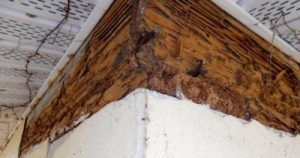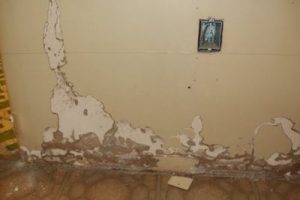
Subterranean termite is a real hidden danger.
The insect leads a highly secret way of life, that is why sometimes it is very difficult to identify the presence of termites’ colony nest inside your house.
Hide content
- How to Identify the Presence of Termites Inside Your House?
- What Areas One Should Examine at First?
- What are The Other Signs of Infestation?
- How long does it take for termites to do damage?
- How Does the Damage Look Like?
- Photo
- How to Prevent the Infestation?
- Useful articles
- Helpful video
- Conclusion
How to Identify the Presence of Termites Inside Your House?
Recommendation: if you do find the evidence of subterranean termites’ infestation, it is highly advisable not to resort to the help of do-it-yourself elimination activities. One should immediately contact the local expert on termites, because the consequences of such negligence could be irretrievable.
To recognize the activity of subterranean termites inside and outside your house, you need a good flashlight, screwdriver or pocketknife and coveralls.
How to spot termite damage? First of all, you should pay attention to damp and warm places (basement), the exterior and interior surfaces of the foundation, particularly construction where wood is on or near the soil.
Start your termite damage inspection with the basement and use a bright flashlight.
Search for mud tunnels and the activity of the swarmers.
Learn more about subterranean termites: signs of their activity; best methods of treatment and DIY methods. Eastern subterranean termites and their tunnels and tubes with photo.
Keep in mind that in almost every house there is old termite damage that could be not noticeable from the first sight, so look carefully.
What Areas One Should Examine at First?
- All wood constructions and materials in the basement and inside the hard-to-get-to spaces;
- all sills, sub floors, joists, support posts, supporting piers, basement window frames, wood under porches;
- take close notice on places where one can find concrete flooring: steps, porches, or slabs join the wooden structure;
- any scrap wood on the exterior of your house, old and rotten tree stumps, fence posts and basement windows exterior frames.
Advice: When performing a periodical inspection of your house, tap wood materials and structures (including furniture) with a large screwdriver. If the wood sounds hollow-like, it might have been damaged by a troublesome termite pest.So, as you can see termite wood damage is not a myth but reality. The surest and most evident sign of infestation – mud tunnels or tubes. Subterranean termites can build their mud tunnel in hard-to-get-to spaces, as well as on the solid structures as walls and the ceiling. Also, we want to mention that wood damaged by termites would be difficult to repair and in most of the cases it is impossible to do.
In principle, termite damage house happens through occupying by them each free piece of space in order to get access to food and moisture. Subterranean termites can construct their tunnels on the following structures:
- On the foundation. Since subterranean termites base their nests under the ground surface, the basement walls are the first place on their way to your house and the easiest one to get in to. Subterranean termites will use each crack, joint or small hole in the foundation to enter the building.
- On the wall. A wall is the next step in termites’ journey to food and moisture. Usually, a mud tunnel on a wall means, that there is a huge “flour and basement” termite activity in your house.
- On the ceiling. Mud tunnels are so fest and solid, that they can keep on a ceiling. Mud tube on a ceiling can mean, that subterranean termite infestation slightly reaches its “scary” scale and the insects are trying to reach the second floor.
As you can see despite the fact that termites damage on wood mostly.
What are The Other Signs of Infestation?
Termites frass (droppings).
These droppings, also called frass or poop, are wood colored.
Such droppings can be found on a bed (the sign of “roof” activity), on window sills, carpet, floor.
Piles of wings. The shed wings of swarmers is a true sign that the subterranean termites have entered their next phase of development. You can often found shed wings on the window sills.
Damaged or hollow-sounding wood. Termites can destroy wood material from the inside, at the same time the wood external appearance stays normal.
If wood sounds hollow when tapped, it may be because termites are eating the wood from the inside out.
Pattern in the wood. Subterranean termites eat and destroy soft wood and eat along the grain. This causes an evident and highly visible honeycomb pattern inside the wood.
Be careful! It is crucial to stop subterranean termites as soon as the infestation is discovered.Learn more about drywood termites: signs of their activity; best methods of treatment: spot treatment and DIY methods; how to get rid of them in furniture?
How long does it take for termites to do damage?
Termite colonies work 24 hours a day. Sometimes, termite infestations go undiscovered until serious damage is already done to a structure. The damage “actions” can last from 1 to 8 years.
It is quite a difficult question to answer how long does it take to cause first structural damage to a house from a moment of infestation to serious destruction.
This issue depends on different factors: the material of a house, its age, technical condition, humidity and temperature levels. As a rule, time interval is about 1-2 years.Infestations can occur two ways. First, healthy colonies send out winged reproductives to start new colonies. When the termites find a suitable area, they will start a new colony.
The second way infestations occur is when subterranean termites forage for food and find their way into a structure. The first signs of infestation: mud tubes (on walls, ceiling, floor), piles of wings.
To destroy the structural integrity of a house for termites is a matter of time.
As a rule, it takes them from 5 to 8 years approximately. The serious termite structural damage looks like:
- rotten and hollow like joisting;
- rotten and hollow like roof timber;
- invaded basement structures;
- patterns and holes in framework;
- swollen ceilings and floors.
Now when you have an idea about how long does it take for termites to cause damage, let’s move to the appearance of the harm effect.
How Does the Damage Look Like?
The damage produced by termites (buckling wood, swollen floors and ceilings, areas that appear to be suffering from slight water damage and visible mazes within walls or furniture) could be confused with mildew and mold.
Termite droppings (brown piles of dust-like frass) could be taken for a dust or an old sawdust.
If you have found a structure similar to mud tube, there is a way to check whether it is active or abandoned: if you want to receive evidence that you have found exactly a mud tube made by subterranean termites, you can remove the portion of a tunnel with a screwdriver and see if there are still termites inside.
If you see an active movement inside with termites running back and forward it means, that you have a serious infestation. If the tunnel is empty, you can check it in a few days and see, whether the tube is repaired.
Warning: Even if it is not repaired it does not mean, that the insects have abandoned your house for ever. It means, probably that they have built a new tube somewhere nearby.Photo
The examples of termite damage on pictures below:
How to Prevent the Infestation?
It is necessary to speak about prevention methods as it always easier to prevent than to deal with the serious consequences of infestation.There are several preventive measures that will help you not to earn serious problems:
- Avoid moisture accumulation near the foundation. Moisture and damp are the main termites’ “friends”. These insects need water to maintain their colony safe and sound. Divert water away with properly functioning downspouts, gutters and splash blocks.
- Reduce humidity in crawl spaces with proper ventilation. When constructing the house, make sure that the basement has a sound vent system to get in and out a portion of fresh air. If there are some bushes or plants near vent ports that prevent proper vent circulation inside the basement, remove these plants.
- Remove piles of trash and dead trees stumps from the area – such objects can attract termites.
- Avoid direct wood-to-ground contact when building porches or decks.
- Siding, brick veneer or foam insulation should not extend below soil grade.
Here you can learn more information about effective treatment method called tenting (fumigation): dangers for termites, preparing for fumigation and cleaning after, how long does this procedure last?
Useful articles
If you interested in more information of termites we recommend you to read the following articles:
- All types of termites. Are they harmful to humans? Can they bite you? And what is the difference between drywood and subterranean ones?
- What does swarmers of different species look like: drywood, subterranean, formosan?
- Signs of infestation outside and in the house: in walls or furniture.
- What does termite holes look like? What is droppings and is it toxic to humans? Do termites make noises?
- How does termite damage look like? Examples of damage in walls and wood floors.
- All about flying termites: how do they look like, swarming season and what to do if there are swarmers in your house?
- How do they do nests and mounds? How to find it in your garden or inside the house?
- Termite life cycle – from egg to larvae. And social hierarchy: workers, soldiers, queen.
Helpful video
Check out this video to see real damage of termites:
Conclusion
The best option is to prevent the appearance of termites in your house, though they are not always possible to detect before it became a real problem.
Nowadays there are many accessible and safe methods to destroy termites’ colony.
But only a specialist from termite control service will help you to choose the best option to get rid of the pests inside your house for a long-time.







